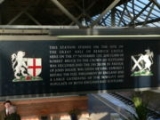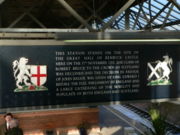
Berwick Castle
Encyclopedia
Berwick Castle is a ruined castle in Berwick-Upon-Tweed
, Northumberland
, England.
The castle was founded in the 12th century by the Scottish King David I
. In 1296-8, the English King Edward I
had the castle rebuilt and the town fortified, before it was returned to Scotland. In 1330 "Domino Roberto de Lawedre" of The Bass
, described as Custodian or Keeper of the Marches and the Castle of Berwick-upon-Tweed, received, apparently upon the termination of his employment there, £33.6s.8p, plus a similar amount, from the Scottish Exchequer. The town and castle changed hands several times during the English-Scottish conflicts.
In 1464 the Exchequer Rolls of Scotland record that Robert Lauder of Edrington
was paid £20 for repairs made to Berwick Castle. In the 16th century, during the reign of Elizabeth I
, the walls were strengthened with the addition of two semi-circular artillery flanking towers, one at the river's edge and the other on the angle of the curtain wall.
The castle's location in the hotly disputed border country between England and Scotland made it one of the most important strongholds in the British Isles, and it enjoyed an eventful history. As a major tactical objective in the region, the castle was captured by both the English and Scots on a number of occasions and frequently sustained substantial damage; Edward I
used it as his headquarters during the course of his invasions of Scotland. The castle also changed hands in less violent circumstances when the English King Richard I (the Lionheart) sold the castle to the Scots, to help fund the Third Crusade
.
The construction of modern ramparts around Berwick in the sixteenth century rendered the castle obsolete and its later history is one of steady decline. Large parts of the structure were simply used as a quarry (notably for the construction during the Commonwealth of the parish church, Holy Trinity, while in the nineteenth century, the Great Hall
and much of what remained was demolished to make way for Berwick-upon-Tweed railway station
. The railway platforms now stand where King Edward took oaths of allegiance from Scottish nobility in 1296, marked by a large notice to that effect. The principal surviving part of the structure is the late thirteenth century White Wall and the steep and long flight of steps known as the Breakneck Stairs. It is now administered by English Heritage
The principal surviving part of the structure is the late thirteenth century White Wall and the steep and long flight of steps known as the Breakneck Stairs. It is now administered by English Heritage
.
Berwick-upon-Tweed
Berwick-upon-Tweed or simply Berwick is a town in the county of Northumberland and is the northernmost town in England, on the east coast at the mouth of the River Tweed. It is situated 2.5 miles south of the Scottish border....
, Northumberland
Northumberland
Northumberland is the northernmost ceremonial county and a unitary district in North East England. For Eurostat purposes Northumberland is a NUTS 3 region and is one of three boroughs or unitary districts that comprise the "Northumberland and Tyne and Wear" NUTS 2 region...
, England.
The castle was founded in the 12th century by the Scottish King David I
David I of Scotland
David I or Dabíd mac Maíl Choluim was a 12th-century ruler who was Prince of the Cumbrians and later King of the Scots...
. In 1296-8, the English King Edward I
Edward I of England
Edward I , also known as Edward Longshanks and the Hammer of the Scots, was King of England from 1272 to 1307. The first son of Henry III, Edward was involved early in the political intrigues of his father's reign, which included an outright rebellion by the English barons...
had the castle rebuilt and the town fortified, before it was returned to Scotland. In 1330 "Domino Roberto de Lawedre" of The Bass
Bass Rock
The Bass Rock, or simply The Bass, , is an island in the outer part of the Firth of Forth in the east of Scotland. It is approximately offshore, and north-east of North Berwick. It is a steep-sided volcanic rock, at its highest point, and is home to a large colony of gannets...
, described as Custodian or Keeper of the Marches and the Castle of Berwick-upon-Tweed, received, apparently upon the termination of his employment there, £33.6s.8p, plus a similar amount, from the Scottish Exchequer. The town and castle changed hands several times during the English-Scottish conflicts.
In 1464 the Exchequer Rolls of Scotland record that Robert Lauder of Edrington
Edrington
Edrington is a medieval estate occupying the lower part of Mordington parish in Berwickshire, Scottish Borders, Scotland, five miles west of Berwick-upon-Tweed. From probably the 14th century, if not earlier, a castle occupied the steep hill above the mill of the same name on the Whiteadder Water...
was paid £20 for repairs made to Berwick Castle. In the 16th century, during the reign of Elizabeth I
Elizabeth I of England
Elizabeth I was queen regnant of England and Ireland from 17 November 1558 until her death. Sometimes called The Virgin Queen, Gloriana, or Good Queen Bess, Elizabeth was the fifth and last monarch of the Tudor dynasty...
, the walls were strengthened with the addition of two semi-circular artillery flanking towers, one at the river's edge and the other on the angle of the curtain wall.
The castle's location in the hotly disputed border country between England and Scotland made it one of the most important strongholds in the British Isles, and it enjoyed an eventful history. As a major tactical objective in the region, the castle was captured by both the English and Scots on a number of occasions and frequently sustained substantial damage; Edward I
Edward I of England
Edward I , also known as Edward Longshanks and the Hammer of the Scots, was King of England from 1272 to 1307. The first son of Henry III, Edward was involved early in the political intrigues of his father's reign, which included an outright rebellion by the English barons...
used it as his headquarters during the course of his invasions of Scotland. The castle also changed hands in less violent circumstances when the English King Richard I (the Lionheart) sold the castle to the Scots, to help fund the Third Crusade
Third Crusade
The Third Crusade , also known as the Kings' Crusade, was an attempt by European leaders to reconquer the Holy Land from Saladin...
.
The construction of modern ramparts around Berwick in the sixteenth century rendered the castle obsolete and its later history is one of steady decline. Large parts of the structure were simply used as a quarry (notably for the construction during the Commonwealth of the parish church, Holy Trinity, while in the nineteenth century, the Great Hall
Great hall
A great hall is the main room of a royal palace, nobleman's castle or a large manor house in the Middle Ages, and in the country houses of the 16th and early 17th centuries. At that time the word great simply meant big, and had not acquired its modern connotations of excellence...
and much of what remained was demolished to make way for Berwick-upon-Tweed railway station
Berwick-upon-Tweed railway station
Berwick-upon-Tweed railway station is a railway station which serves the town of Berwick-upon-Tweed in Northumberland. It is located on the East Coast Main Line, 335 miles north of London Kings Cross and 55 miles south of Edinburgh Waverley...
. The railway platforms now stand where King Edward took oaths of allegiance from Scottish nobility in 1296, marked by a large notice to that effect.

English Heritage
English Heritage . is an executive non-departmental public body of the British Government sponsored by the Department for Culture, Media and Sport...
.
Governors, or Keepers, of the castle
- Sir William Douglas, 1294-1296 surrendered to Edward I of EnglandEdward I of EnglandEdward I , also known as Edward Longshanks and the Hammer of the Scots, was King of England from 1272 to 1307. The first son of Henry III, Edward was involved early in the political intrigues of his father's reign, which included an outright rebellion by the English barons...
following the Massacre of Berwick - Maurice de Berkeley, 2nd Baron BerkeleyMaurice de Berkeley, 2nd Baron BerkeleyMaurice Berkeley, 2nd Baron Berkeley , sometimes termed The Magnanimous, was an English baron and rebel....
, English governor c.1314 - Edmond de CaillouEdmond de CaillouEdmond de Caillou or Raymond de Caillou, was a Gascon soldier who fought during the First War of Scottish Independence.-Life:...
, Gascon governor for the English, Killed at the Battle of SkaithmuirBattle of SkaithmuirThe Battle of Skaithmuir was a skirmish of the First War of Scottish Independence. It took place near Coldstream, on the Anglo-Scottish border, in February 1316. The skirmish was fought between the Scottish captain Sir James Douglas, and an English raiding party from Berwick upon Tweed, under...
1316. - Sir Robert Lauder of The Bass, to circa 1330.
- Robert Lauder of EdringtonEdringtonEdrington is a medieval estate occupying the lower part of Mordington parish in Berwickshire, Scottish Borders, Scotland, five miles west of Berwick-upon-Tweed. From probably the 14th century, if not earlier, a castle occupied the steep hill above the mill of the same name on the Whiteadder Water...
(later Robert Lauder of The BassRobert Lauder of The BassSir Robert Lauder of The Bass, was a Scottish knight, armiger, and Governor of the Castle at Berwick-upon-Tweed. He was also a member of the old Scottish Parliament...
), 1461/2-1474. - David, Earl of CrawfordDavid Lindsay, 1st Duke of MontroseDavid Lindsay, 1st Duke of Montrose was a Scottish nobleman.He was the son of Alexander Lindsay, 4th Earl of Crawford, and inherited the Earldom of Crawford on his father's death in 1453...
, 1474-1478. - Sir Robert Lauder of Edrington, Knt., 1478-1482.
- Sir Patrick Hepburn, 1st Lord Hailes, 1482 (last Scottish governor).
- Sir William DruryWilliam DrurySir William Drury, Knt., was an English statesman and soldier,He was a son of Sir Robert Drury of Hedgerley in Buckinghamshire, and grandson of another Sir Robert Drury , who was speaker of the House of Commons in 1495. He was a brother of Dru Drury.He was born at Hawstead in Suffolk, and was...
(d.1579), Marshal of Berwick-upon-Tweed, before 1564. - Francis Russell, 2nd Earl of BedfordFrancis Russell, 2nd Earl of BedfordFrancis Russell, 2nd Earl of Bedford, KG was an English nobleman, soldier and politician and godfather to Sir. Francis Drake.-Early life:...
, appointed 1564 - Sir George BowesGeorge Bowes (soldier)Sir George Bowes was an English military commander.-Life:George Bowes was the son of Richard Bowes and Elizabeth Aske. At the age of fourteen he was married to Dorothy, daughter of Sir William Mallory of Studley Royal. He early went to the Scottish war, and in 1549 is mentioned as being in command...
of Streatlam, co.Durham (d.1580), Marshal of Berwick. In 1568 he escorted Mary, Queen of Scots, from Carlisle to Bolton CastleBolton CastleBolton Castle in North Yorkshire, is located in Wensleydale in the Yorkshire Dales . The nearby village Castle Bolton takes its name from the castle. The castle is a Grade I listed building and a Scheduled Ancient Monument. The castle was damaged in the English Civil War, but much of it remains...
. His sister Margery married John KnoxJohn KnoxJohn Knox was a Scottish clergyman and a leader of the Protestant Reformation who brought reformation to the church in Scotland. He was educated at the University of St Andrews or possibly the University of Glasgow and was ordained to the Catholic priesthood in 1536...
.

